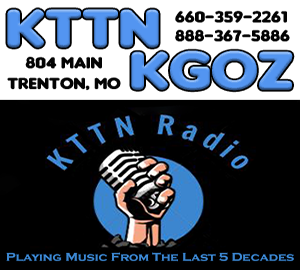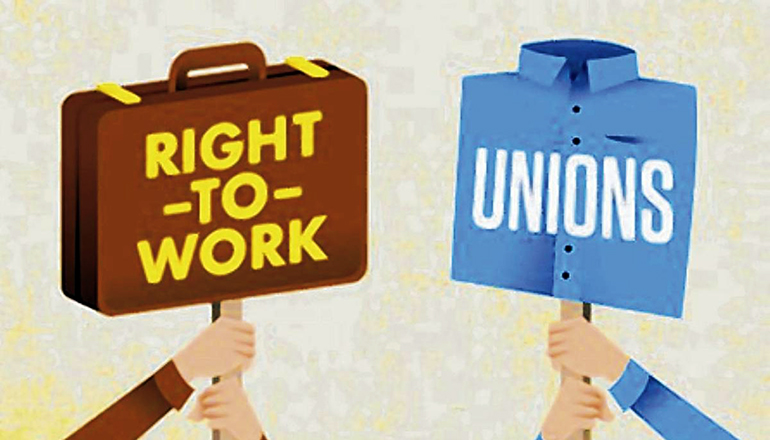The term “right to work’ relates to or promotes the right of a worker to be able to obtain employment without being required to join a labor union to do so. When right to work laws are in place, workers cannot be compelled to pay for any cost of union representation, even if the union is active in the workplace and represents many of the other employees.
It is a government regulation of contractual agreements between labor unions and employers to prevent the exclusion of non-union workers.
The advantage of having right to work provisions in place is that it allows skilled workers to find beneficial employment while preserving their paycheck for their own needs. Some unions may require dues of up to 3.5%, which can take a healthy cut out of a worker’s take-home pay.
The disadvantage of having right to work provisions in place is that it enhances the at-will nature of most employment contracts. In an at-will environment, any justifiable reason for termination can cause a worker to lose their job. That reason does not need to be performance related for the termination to be lawful. Although a termination without disciplinary action may allow for unemployment benefits to be obtained, it lessens the protections of workers for their daily employment.
Here are some of the pros and cons of right to work to think about before heading to the polls to cast your vote.
Here Are the Pros of Right to Work Provisions
It provides an opportunity for equal due process.
Without right to work statutes, workers without union representation would be at a disadvantage to those with union representation. By having these provisions in place, minority rights can still be implemented and due process can be achieved. Although there may still be some power conveyed to the majority in a unionized environment, because everyone benefits from that representation, each person can have their voice heard.
It provides freedom of association.
There is no forced unionism when right to work laws are in place. Workers can still decide to join a union if they wish. They also have the option to not join a union if they wish. Instead of forcing people into a collective bargaining agreement that may not represent their best wishes, they can choose to still work and not be forced to financially support an organization they feel does not have their best interests in mind.
It stops unwanted political contributions.
Labor unions typically support political candidates at all levels of government. That support comes from the funds that are collected through union fees. In right to work provisions, workers can stop contributions to a union when they feel like the support is going in a way that is not representative of their views. In some states, even union workers can divert the funds that would be used for a political contribution to other resources.
It classifies the union as a fee-for service business.
Unions are essentially a business that provides a service to its customers in exchange for the fees that are charged. When workers join a union, they are purchasing bargaining and grievance services. The goal is to create a union that must deliver upon its promised values. If a worker feels like the union is not providing an appropriate level of value, then they can “fire” the union and look for other services under these provisions.
It creates a competitive bidding process.
There are higher levels of economic growth in states that adopt right to work statutes compared to states that do not. That occurs because a more competitive bidding process for employees can be initiated, which naturally boosts wages due to the principles of supply and demand. That allows for higher levels of economic growth to be achieved and the potential for workers to receive much higher wages than what may be negotiated in a collective bargaining agreement.
Unions serve a different role than they once did.
In the past, unions were absolutely necessary for workers. There were few, if any, workplace safety laws in place or enforced. Wages were terrible, especially before the minimum wage laws were passed. Employees could be forced to work long hours repetitively under the threat of losing their jobs if they did not. Today’s unions serve a different purpose in representation and that is why their membership rolls have been declining. There isn’t the same need for safety and protection.
More workers are typically employed in right to work states.
Right to work states average an employment to population ratio that is 1.4% higher than in states without right to work provisions.
It can reduce property tax levies.
Many public schools are funded by property tax levies. One of the largest costs of those levies is teacher salaries and benefits. By offering right to work laws that can protect teacher wages, along with other public-sector employees that are also supported by taxpayer funding, the value of collected tax revenues can be stretched further. In some instances, homeowners may even be able to see fewer property taxes assessed when right to work provisions are in place.
It restores accountability.
Unions are required to be accountable for their workers and the fees that are collected under right to work provisions. Instead of working toward the monopolization of a workplace, right to work offers a guarantee that a worker can take action against a union if they feel it is underperforming. That includes an ability to see out union representation from another group if they prefer.
It can limit corruption.
When there is a lack of oversight present, then there is a chance for corruption to grow. Labor unions experience a minimal amount of corruption when operating in right to work environments because they are held accountable to their actions. In extreme instances, this level of accountability can reduce the amount of union fees being collected or give workers more influence over what happens in the day-to-day operations of the union.
Here Are the Cons of Right to Work Provisions
It isn’t really a right to work.
What the right to work provisions do is offer workers the chance to take advantage of the union benefits in a workplace without actually paying for that representation in any way. This allows them to be “free riders.” Unions that are bargaining on the behalf of their members must also bargain for everyone in that unit fairly, including non-represented workers. That means the goal of the provision is to undercut the ability of the union to negotiate more than it is to provide an employee with a chance to work.
Non-represented workers can force the grievance process.
Laws in the United States require unions to provide a duty of fair representation. Workers can, therefore, disagree with the fees being charged for representation, but force the union to provide representation services, such as the grievance process, on their behalf. This creates an artificial burden on the labor union, negating the freedom of contract and value that can be offered.
Right to work lobbyists are funded by anti-union businesses.
The National Right to Work Committee was formed by a group of southern businessmen with one sole purpose: to fight the establishment of unions. The Legal Defense Foundation and the National Right to Work Committee have received millions in grant money that comes from foundations controlled by anti-union industrialists, such as the Olin Foundation. This provides further optics that these provisions are more about controlling the unions than providing people with meaningful employment opportunities.
Many police, firefighter, and EMT unions are excluded from right to work provisions.
Many of the labor unions that are targeted by right to work laws will often support Democratic candidates for political office. Many of the legislatures which enact right to work laws are controlled by Republicans. It is another set of optics which looks at these provisions as being a way to control workers instead of providing better wages and benefits for them.
Wages in right to work states are lower.
In a 2011 study presented by the Economic Policy Institute, wages in states with right to work provisions are more than 3% lower when compared to states without those provisions. That means the same worker in a comparable position will earn less than $1,500 per year in a right to work state using average wages as the basis of the equation. According to data from the AFL-CIO, right to work laws cost workers over $5,500 per year.
Benefits are fewer in right to work states.
In states that have right to work provisions, the rate of employer-sponsored health insurance is more than 2.5% lower compared to states without right to work laws. The rate of employer-sponsored pensions is nearly 5% lower in right to work states as well. Employers also spend much less on training and ongoing educational opportunities for workers in right to work states, averaging more than $2,500 less per worker.
Injury and death rates are higher in right to work states.
The Bureau of Labor Statistics reports that injury rates in right to work states are more than 50% higher than it is in states without right to work laws.
Unions may cease to exist in the right to work environment.
When workers are given the option to pay a union for representation or not pay a union for representation, many will choose the latter option. With fewer paying members, a labor union has fewer opportunities to provide quality representation. Over time, that can cause the union to abandon the workplace because they have no funds to provide representation. Should that happen, individual workers would be required to stand up for their rights and that doesn’t have the same power as a unified voice.
It tilts the balance of power back to the employers.
When a labor union is present, you have a group of management facing off against a group of workers that are being represented. Without the union present, the conflict becomes a group of managers against individual workers. This forces workers to accept the demands of the employer or risk losing their job and that can result in reduced pay, fewer benefits, or longer hours. When a side is unified, it is more likely to be successful.
Corruption still occurs even in right to work states.
Anyone leadership group can be corrupt. With right to work laws, workers could be trading corrupt union leadership for corrupt organizational leadership – or worse, corrupt political leadership. If the goal is to fight corruption, then there must be a balance in place that protects the rights and power of a unified voice for the employee with the unified voices of others in leadership positions.
The pros and cons of right to work provisions show us that the ability to have the freedom to choose representation is still important. One could argue that choosing a non-union workplace in a state without right to work laws still offers that freedom, but others say that any workplace should be an option for a potential employee without the threat of union fees or forced representation.







